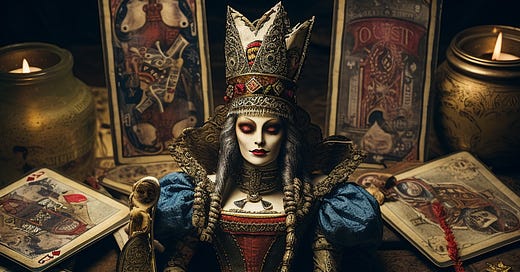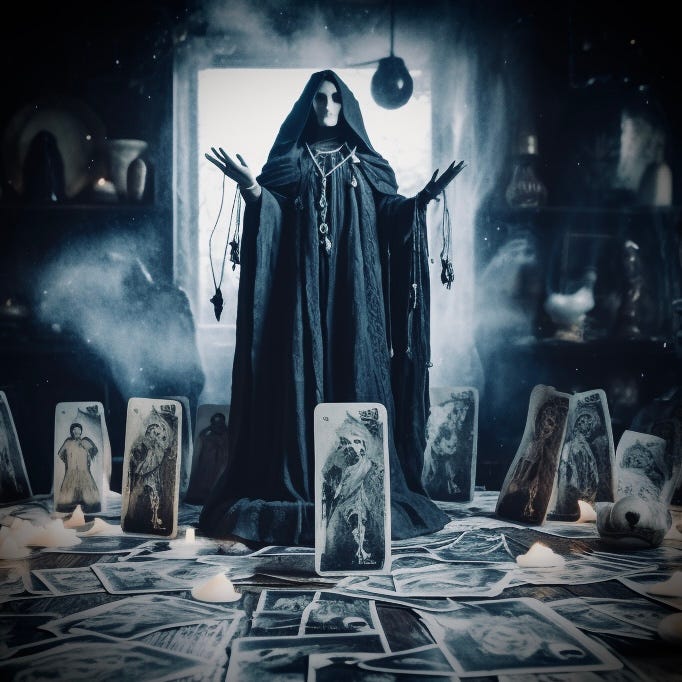The Fifth Suit
Once upon a time, a wicked queen lived in a castle high in the Asturias. The queen possessed staggering powers of divination, aided as she was by a tarot deck she had acquired long ago from a Castilian witch. By these cards, she was able to disrupt all plots set against her, and devise subtle means to seize the lands and legacies of her family and her foes. Yet despite all this, she was discontented. For she held no sway over the prophetic spirits on the other side of the cards whom she regarded as her slaves.
The queen was convinced that her powers had been limited by the deck itself, which consisted of only four suits: wands, cups, coins, and swords. “If this deck had five suits,” she lamented, “I would be able to step through it to the other side and subjugate the unseen legions who refuse to bend their knee to my will.”
She knew that the spirits were aware of her intentions, for the cards had told her as much, warning her that if she did not reach the other side by the first full moon of winter, the hidden realm behind the cards would be forever inaccessible to her.
And so she summoned a young man in the village in the valley below, who was reputed to be both a gifted painter and a clever magician. She promised him wealth beyond his wildest dreams, if (by the appointed hour) he would create for her a tarot deck consisting of five suits. Then with a cruel grin she added that, if he refused, and if he did not complete his commission by the first full moon of winter, he would be beheaded and disemboweled in the dungeon. “And not necessarily in that order.”
The young man had no choice. He asked what the fifth suit was to be.
“The suit of cards.”
“Of cards?” he asked.
“The suit of cards,” she repeated. “And with this deck I shall enter into the unseen realm of prophecy. And once I have quelled its rebellious sprites, I shall become mistress of all and queen of the seen and unseen world.”
The young man was taken to the castle’s tallest tower where he was locked up, fed and given all the materials he needed to complete his task. He labored night and day as the winter solstice drew near. But on the day of the first moon, as the sun began its descent, the young man wept and tore his hair. For he had finished all but one card, whose paint had not yet dried. It could not be inserted into the deck because the paint would run when the cards were shuffled. The unfinished card was of the Major Arcana. It was The Magus, whose eponymous figure the young man had modeled on himself. On the table in front of The Magus an emblem representing each of the five suits had been painstakingly drawn: a wand, a cup, a coin, a sword, and a card.
The paint-dampened card was affixed to a diminutive easel bracketed to a table, on the surface of which lay the young man’s brushes and magical paints made of bat blood, cat bile and the pulverized bones of wolves.
The magician’s only hope was to employ a deception. He would present the incomplete deck to the queen and, with luck, she would not notice the missing card. From behind the bars he called out to his warders and informed them that he had finished his work and was ready to see the queen.
Two guards led him to the catacombs beneath the castle’s demolished chapel. The walls of the catacombs were adorned with human skulls and upturned crucifixes. The queen stood over a brazier, burning one by one the cards from the Castilian deck.
Forced to his knees, the magician proffered a pouch of crimson velvet with eyes lowered. The pouch contained the entire deck (sans The Magus card). With long pale fingers the queen seized the pouch and ordered the young man to be returned to his cell to await his execution at dawn.
Then she turned to a black marble table on which a single taper burned, unfastened the leather strings, and excitedly removed the cards from the pouch. She shuffled the deck, cut it in half and turned over the top card. It was the Queen of Cards, whose image bore a striking resemblance to her. In fact, not only did the figure resemble her, it stood at a black marble table on which a single taper burned, as if poised in the act of turning over the very card she was looking at.
A scream echoed through the castle, as the guards hurled the magician into his tower cell. The young man stood up and saw that the paint was oozing down card of The Magus, leaving only a rust-colored stain in the depths of which the laughing faces of the prophetic spirits on the other side could be seen. Then the man himself was dragged into the card, which caught fire and flew off the easel and out the oriel window, fluttering in the swift-rolling fog that filled the mountain valley as the first full winter moon rose high over the Asturias.
No one ever learned what happened to the queen—or to the poor young magician in the tower. But the castle began to crumble and decay shortly after the incident described. To this day, the ruinous heap looms over the wooded valley in northwestern Spain and is said to be haunted. Itinerant fortune-tellers sometimes bury their tarot cards beneath the castle’s flagstones when they suspect they are about to die.
There is an interesting coda to this tale, for the magician did not belong to the world of men—a fact he himself knew nothing about during the time he lived within it. Fearing the queen’s growing might, the prophetic spirits on the other side of the cards had dispatched one of their own to be raised as a man in the sleepy village at the castle’s base, since they had glimpsed into the future and had seen how the Queen of Cards would one day overplay her hand.







Thanks for that - what a fun fairytale.
I really really liked this, Daniel! Combining particular interests of mine - Asturias, tarot, magic - all in one story! Bravo!!